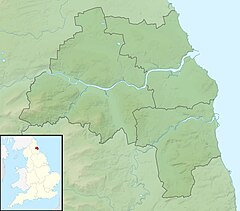Whitburn Lifeboat Station
| Whitburn Lifeboat Station (Closed) | |
|---|---|
 | |
 Whitburn Bay | |
| General information | |
| Type | RNLI Lifeboat Station |
| Address | Whitburn Bents Rd |
| Town or city | Whitburn, Tyne and Wear, SR6 7NX |
| Country | England |
| Coordinates | 54°56′39.2″N 1°21′52.6″W / 54.944222°N 1.364611°W |
| Opened | 1818 (SLC) 1854 (RNLI) |
| Closed | 1918 |
| Owner | |
Whitburn Lifeboat Station is a former Royal National Lifeboat Institution (RNLI) station, which was located in the village of Whitburn, in the county of Tyne and Wear.
A lifeboat was first stationed here in 1818, by the Sunderland Lifeboat Committee (SLC). Management of the station was handed over to the RNLI in 1854.[1][2]
After 100 years service, Whitburn lifeboat station was closed at the end of April, 1918.[1]
History[edit]
Inspired by the rescue efforts made to the vessel Ajax, wrecked on her maiden voyage just north of Sunderland harbour, Lord Dundas set about raising funds for a lifeboat. Thus was created the Sunderland Lifeboat Committee.[3]
In 1818, a new lifeboat station was opened at Whitburn by the Sunderland Lifeboat Committee, transferring a lifeboat from their 'North Side' station. A new boathouse was built at Marsden, on the north side of Whitburn. The 27-foot 6in boat had been built in 1800 by William Wake of Sunderland, influenced by the design of Henry Greathead. In 1830, Rev. Thomas Baker of Whitburn wrote to the Royal National Institute for the Preservation of Life From Shipwreck (RNIPLS) for help with the provision of a replacement lifeboat for Whitburn. With funds raised by the Rev. Baker, and a grant of £50 from Lloyd's, another 27-foot boat, costing £100, arrived in September 1830.[2]
In May 1854, the Rev. Baker again wrote to the RNIPLS, requesting that the Institution take over the running of the station, which they did, with the Institution becoming the RNLI later that year. No detailed records of service are available, but it is noted that at least 70 lives were saved by the two boats.[2]
The station was relocated in 1859, with a new boathouse constructed just to the south of Whitburn, at 'The Bents'. The RNLI also provided a new boat to Whitburn in 1859. A 32-foot Self Righting 'Pulling and Sailing' (P&S) lifeboat, (one with oars and sails), costing £172-1s-0d, was constructed by Forrestt of Limehouse, London. The boat was named Thomas Wilson after the former chairman of the RNIPLS, a native of the area.[4] On 12 January, 1864, battered by roughs seas, the Whitburn lifeboat saved the lives of 7 crew from the steam-tug Rob-Roy, aground off Whitburn.[5]
A replacement 32-foot lifeboat, provided again from RNLI funds, and again named Thomas Wilson, arrived on station in September 1865. In November 1866, the boat launched to the barque Margaret and Jane, aground on the rocks at Whitburn, and rescued 8. Within 24 hours, she was launched again to the Caroline Elizabeth, rescuing 13.[6]
Two further lifeboats were placed at Whitburn. Provided by the gift of Miss C. L. Preston, they were both named William and Charles. They would be launched a total of 34 times, and save the lives of 107. With the consideration that faster more capable motor lifeboats had been placed at Sunderland and Tynemouth, the Whitburn lifeboat station was closed at the end of April, 1918.[1][2]
The William and Charles (ON 500) was placed on the relief fleet for a further 8 years. No evidence of either boathouse remains, with the site of the 1859 boathouse at 'The Bents' now occupied by the clubhouse for the Whitburn Angling Club.[1]
Station honours[edit]
The following are awards made at Whitburn.[7]
- Eleanor Galbraith - 1855
- William Rae, Fisherman - 1855
Whitburn lifeboats[edit]
| ON[a] | Name | In service[8] | Class | Comments |
|---|---|---|---|---|
| – | Unknown | 1818−1830 | 27-foot 6in non-self-righting Greathead type | (SLC) [Note 1] |
| – | Unknown | 1830−1859 | 27-foot non-self-righting North Country type | (SLC) [Note 2] |
| – | Thomas Wilson | 1859−1865 | 32-foot Self-righting (P&S) | [Note 3] |
| – | Thomas Wilson | 1865−1881 | 32-foot Self-righting (P&S) | [Note 4] |
| 179 | William and Charles | 1881−1902 | 34-foot Self-righting (P&S) | [Note 5] |
| 500 | William and Charles | 1902−1918 | 35-foot Self-righting (P&S) | [Note 6] |
- ^ ON is the RNLI's Official Number of the boat.
See also[edit]
Notes[edit]
- ^ 27-foot 6in 10-oared non-self-righting lifeboat, built in 1800 by William Wake of Monkwearmouth, Sunderland.
- ^ 27-foot non-self-righting North Country type lifeboat, built by Wake of Sunderland.
- ^ 32-foot 10-oared Self-righting (P&S) lifeboat, costing £172-1s-0d, built by Forrestt of Limehouse, London.
- ^ 32-foot 10-oared Self-righting (P&S) lifeboat, costing £252, built by Forrestt of Limehouse, London.
- ^ 34-foot 10-oared Self-righting (P&S) lifeboat, costing £363, built by Woolfe of Shadwell.
- ^ 35-foot 10-oared Self-righting (P&S) lifeboat, costing £781, built by Thames Ironworks.
References[edit]
- ^ a b c d Leonard, Richie; Denton, Tony (2024). Lifeboat Enthusiasts Handbook 2024. Lifeboat Enthusiasts Society. pp. 4–132.
- ^ a b c d Morris, Jeff (December 1999). Sunderland Lifeboats (1800–2000). Lifeboat Enthusiasts Society. pp. 1–14.
- ^ "Shipwrecks". Caledonian Mercury. No. 12216. 6 January 1800.
- ^ "The Late Thomas Wilson, Esq". The Lifeboat. 1 (7). December 1852. Retrieved 24 May 2024.
- ^ "Shipping Intelligence". Caledonian Mercury. No. 23260. Edinburgh. 22 January 1864.
- ^ "Shipping Disasters. A Shields Brig Lost, and a Barque Ashore". Dundee Courier. No. 4159. Dundee. 4 December 1866.
- ^ Cox, Barry (1998). Lifeboat Gallantry. Spink & Son Ltd. ISBN 0-907605-89-3.
- ^ Leonard, Richie; Denton, Tony (2021). Lifeboat Enthusiasts Handbook 2021. Lifeboat Enthusiasts Society. pp. 2–120.

